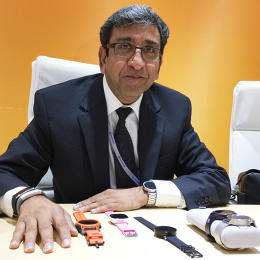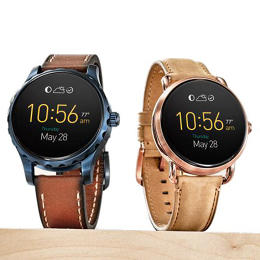Qualcomm’s Wearable Boss On Why There’s No Moore’s Law For Smartwatches
To understand how excited Pankaj Kedia gets about wearable tech, you only need to look at his wrists.
Sitting in a small meeting room at the CES trade show in early January, Qualcomm’s senior director and business lead for smart wearables has two fitness trackers on his right arm, and an Android Wear smartwatch on his left. And that’s not all. A GPS tracker is hooked to his briefcase, from which he pulls out another five smartwatches over the course of our chat.
“I could spend four hours just brainstorming with you on the possibilities around use cases [for wearables],” Kedia says. “We are barely scratching the surface.”
As a provider of chips for more than 100 types of wearables—and as the world’s largest provider of mobile processors—Qualcomm probably has a good sense of where things are headed. But the current wearable business, which revolves around smartwatches and fitness bands, is in an awkward phase. New smartwatches were absent from the booths of major vendors such as LG and Samsung—the former is reportedly waiting for Google’s Android Wear 2.0 operating system to arrive—and Lenovo said in December that it wouldn’t be making another smartwatch anytime soon. IDC saw a sharp decline in smartwatch shipments during third-quarter 2016, the last time it released estimates, and some analysts say that last year’s wearable sales didn’t live up to expectations.
Kedia, however, only sees the upsides, even if he can’t talk about everything that’s on the horizon. “We are excited about this space,” he says. “We are growing well, our customers are growing well, we have beautiful products coming out.”
Shrinking The Smartwatch
Ever since companies like Pebble (R.I.P.) and Samsung started making smartwatches, they’ve struggled to make the size of these timepieces more manageable. Even the Apple Watch, whose 38-mm model is smaller than most smartwatches, doesn’t come close to the analog watch styles you often find on more slender wrists. Rumors suggest that the third-generation Apple Watch will have the same design as the first two.

Why haven’t smartwatches shrunk the way smartphones and laptops routinely do? Kedia notes that Moore’s Law—the famous observation that transistor density doubles every couple of years, allowing major gains in performance or power efficiency—doesn’t translate so well to smartwatches.
People will pay a premium for thin and light, he says, but they’ll also pay a premium for more sensors (such as GPS, heart rate, and microphones), greater connectivity (such as Wi-Fi and cellular), and better security. Each of these additions creates a trade-off in power efficiency—another thing that commands a premium—which necessitates a larger device that can accommodate a bigger battery.
“Taking all those things and putting it in a package, that is not easy to do,” Kedia says. “It is not a one-trick pony.”
Design improvements may not be too far off, though. Kedia referenced the upcoming Android Wear 2.0, and said Qualcomm is working with many watch companies that he’s “dying to talk about,” though he added that Qualcomm PR wouldn’t let him. He also pointed to crystal jewelry maker Swarovski, which announced a smartwatch at CES but did not show it or give any details.
“Swarovski will kill me if I gave you more information,” he says, “but think about what Swarovski stands for, and think about what a Swarovski smartwatch might look like.”
He also believes a “Moore’s Law-like soundbite” will eventually exist for wearables, providing a simple metric for analyzing the category’s technological progress.
“I think it will be some combination of size, power, sensors, connectivity, and security,” he says. “It cannot be one thing. In the PC space, in the server space, it was performance and power. Every 18 months, power goes down, performance goes up, you can use one of those. Here it’s multi-headed.”
Smartwatches And Beyond
Even now, Kedia challenges the narrative that smartwatches are in a rut, arguing that they’ve gotten off to a faster start than MP3 players, point-and-shoot-cameras, electric cars, and even the smartphone.

“Do you know how many quarters it took for the iPod to hit a million units? Seven. Do you know how many quarters it took for the iPhone to hit a million units? Three. Do you know how many quarters it took for the smartwatch to hit a million units? One,” Kedia says.
And even if enthusiasm has temporarily cooled, he believes it’s only a matter of time before smartwatches hit their stride. As platforms like Android Wear and Apple’s WatchOS evolve, he believes they’ll start breeding transformative apps, akin to Uber and Snapchat on smartphones.
“Looking back, we have short memories,” Kedia says. “We forget. It takes time to build a new category, and when I talk to you, and I talk to analysts, when I talk internally at Qualcomm, some people assume that the perfect product needs to be today, and it doesn’t work that way. Uber was not born in a day.”
That said, Qualcomm isn’t only making chips for smartwatches. Alongside the Snagdragon Wear 2100 smartwatch chip that launched last year, Qualcomm also offers the Snapdragon Wear 1100, which targets fitness trackers and simple wearables that don’t need a full-color touch display. The company is effectively placing bets across the entire wearable market, from smartwatches and fitness bands to smart earbuds and GPS trackers.
The hope is that as wearables get their Moore’s Law equivalent, Qualcomm will be able to power all kinds of everyday objects, from clothing to footwear to other forms of jewelry beyond the wrist.
“There is no such thing as a killer product, or a killer form factor, or a killer shape and size, or a killer use case,” Kedia says. “This will evolve over time.”
Fast Company , Read Full Story
(28)



